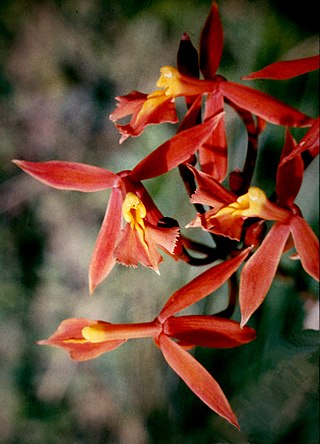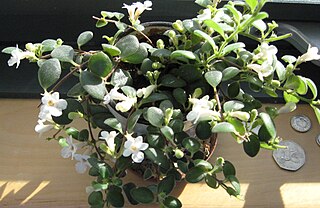Related Research Articles

An epiphyte is a plant or plant-like organism that grows on the surface of another plant and derives its moisture and nutrients from the air, rain, water or from debris accumulating around it. The plants on which epiphytes grow are called phorophytes. Epiphytes take part in nutrient cycles and add to both the diversity and biomass of the ecosystem in which they occur, like any other organism. They are an important source of food for many species. Typically, the older parts of a plant will have more epiphytes growing on them. Epiphytes differ from parasites in that they grow on other plants for physical support and do not necessarily affect the host negatively. An organism that grows on another organism that is not a plant may be called an epibiont. Epiphytes are usually found in the temperate zone or in the tropics. Epiphyte species make good houseplants due to their minimal water and soil requirements. Epiphytes provide a rich and diverse habitat for other organisms including animals, fungi, bacteria, and myxomycetes.

Tillandsia is a genus of around 650 species of evergreen, perennial flowering plants in the family Bromeliaceae, native to the forests, mountains and deserts of the Neotropics, from northern Mexico and the southeastern United States to Mesoamerica and the Caribbean to central Argentina. Their leaves, more or less silvery in color, are covered with specialized cells (trichomes) capable of rapidly absorbing water that gathers on them.

Lithophytes are plants that grow in or on rocks. They can be classified as either epilithic or endolithic; epilithic lithophytes grow on the surfaces of rocks, while endolithic lithophytes grow in the crevices of rocks. Lithophytes can also be classified as being either obligate or facultative. Obligate lithophytes grow solely on rocks, while facultative lithophytes will grow partially on a rock and on another substrate simultaneously.

Epidendroideae is a subfamily of plants in the orchid family, Orchidaceae. Epidendroideae is larger than all the other orchid subfamilies together, comprising more than 15,000 species in 576 genera. Most epidendroid orchids are tropical epiphytes, typically with pseudobulbs. There are, however, some terrestrials such as Epipactis and even a few myco-heterotrophs, which are parasitic upon mycorrhizal fungi.

Carpenter ants are large ants indigenous to many forested parts of the world.

Myrmecophytes are plants that live in a mutualistic association with a colony of ants. There are over 100 different genera of myrmecophytes. These plants possess structural adaptations that provide ants with food and/or shelter. These specialized structures include domatia, food bodies, and extrafloral nectaries. In exchange for food and shelter, ants aid the myrmecophyte in pollination, seed dispersal, gathering of essential nutrients, and/or defense. Specifically, domatia adapted to ants may be called myrmecodomatia.

Myrmecodia is a genus of epiphytic myrmecophytes, native to Southeast Asia and present in Indochina, Malaysia, the Southwest Pacific, the Philippines, and extending south to Fiji and Cape York in Queensland, Australia. It is one of five ant-plant genera in the family Rubiaceae, the others being Anthorrhiza, Hydnophytum, Myrmephytum, and Squamellaria.

Myrmecophily is the term applied to positive interspecies associations between ants and a variety of other organisms, such as plants, other arthropods, and fungi. Myrmecophily refers to mutualistic associations with ants, though in its more general use, the term may also refer to commensal or even parasitic interactions.

The black carpenter ant is one of the largest and most common species of carpenter ant native to the central and eastern United States as well as eastern Canada.

Myrmecophila is a genus of plants belonging to the family Orchidaceae. It is native to southern Mexico, Central America, the West Indies and Venezuela.

Codonanthe is a genus of mainly epiphytic plants in the family Gesneriaceae, endemic to the Atlantic Forest of Brazil. The botanical name comes from the Ancient Greek for 'bellflower'. They have white or pale pink flowers and somewhat fleshy leaves. In 2013, the genus was reduced in size when more than half of the species were transferred to Codonanthopsis. They can be grown as houseplants, particularly in hanging baskets. Artificial crosses with Nematanthus hybrids have produced the hybrid genus × Codonatanthus.

Acromyrmex striatus is a species of the leaf-cutter ants found in the Neotropics.

Dischidia major, the Malayan urn vine, is a plant in the genus Dischidia. They carry modified leaves, offering accommodation to ants, including those of the family Dolichoderinae, and in return gain some sustenance from increased carbon dioxide and nitrogen levels, and a degree of protection from noxious animals and plants. This mutualism trait, known as myrmecophily, is widespread across the plant world and clearly carries considerable benefits for both ants and plant.

Crematogaster carinata is a species of ant in the tribe Crematogastrini. It was first described by Gustav Mayr in 1862. It is native to Central and South America, where it is a common species, forming large colonies in the canopy of the forest.

Hydnophytum formicarum, commonly called a "Baboon's head" or "Ant plant", is an epiphyte native to Southeast Asia and is considered critically endangered in Singapore. It is a myrmecophyte as ants live in its tuber, also known as a caudex, and pollinate its flowers. It resides in open-canopied areas, rainforests, and terrestrial regions of high elevation.

Pachycentria glauca is a small epiphytic shrub in the Melastomataceae family. It has 2 subspecies: P. glauca subsp. glauca and P. glauca subsp. maingayi. The glauca subspecies is endemic to Borneo, the maingayi subspecies is native to Peninsular Malaysia and Thailand, perhaps Sumatra. It grows on trees, other epiphytes and rocks in partial shade. It is intimately associated with particular ant species, growing on their gardens, providing a home for them, feeding them and having its seeds dispersed by them.

Entylia carinata, commonly known as the keeled treehopper, is a species of treehopper in the family Membracidae. They can be found in Brazil, Panama, Mexico, the United States, and Canada. Keeled treehoppers are often attended by ants which feed on the honeydew they excrete. In return, the ants offer protection from predators. Keeled treehoppers typically feed on plants in the aster family and they are not known to transmit plant diseases and are not considered significant plant pests.

Codonanthopsis is a genus of flowering plants in the family Gesneriaceae. Its native range is from southern Mexico through tropical America to Bolivia and most of Brazil. Codonanthopsis species are generally trailing epiphytes with pale flowers. Most have a mutualistic relationship with tree-living ants: the plants provide the ants with food, including nectar, and give their nests structure and support, while the ants disperse the plants' seeds. The genus was considerably expanded in 2013 when species were transferred from Codonanthe. Some Codonanthopsis species are cultivated as houseplants, when they may be grown in hanging baskets.

Dischidia astephana is a species of plant in the genus Dischidia native to Peninsular Malaysia and Borneo. A vining epiphyte that can cover an entire tree branch in dense leaves, it is often found growing near other Dischidia including D. albida,D. parvifolia, and D. vadosa. Its leaves are shaped like flat rings or domes, some of which will be tightly appressed to the surface of the tree where it grows. It lives symbiotically with ants of the Crematogaster genus on trees, with the roots growing inside ant nests and using debris for nutrients.
Codonanthopsis anisophylla is a species of flowering plant in the family Gesneriaceae. This species is native in Guyana and mainly grows in wet tropical biomes. The species was first described in the genus Paradrymonia from a specimen collected in 1960, and transferred to Codonanthopsis in 2013.
References
- 1 2 3 Jolivet, Pierre (1998). Interrelationship Between Insects and Plants. CRC Press. pp. 139–140. ISBN 978-1-4987-1936-0.
- 1 2 Capinera, John L. (2008). Encyclopedia of Entomology. Springer Science & Business Media. pp. 178–183. ISBN 978-1-4020-6242-1.
- ↑ Chautems, Alain & Perret, Mathieu (2013). "Redefinition of the Neotropical Genera Codonanthe (Mart.) Hanst. and Codonanthopsis Mansf. (Gesneriaceae)" (PDF). Selbyana. 31 (2): 143–156. Retrieved 2021-04-05.
- ↑ Marini-Filho, Onildo J. (1999). "Distribution, composition, and dispersal of ant gardens and tending ants in three kinds of central Amazonian habitats". Tropical Zoology. 12 (2): 289–296. doi: 10.1080/03946975.1999.10539395 .
- ↑ Weissflog, Andreas; Kaufmann, Eva; Maschwitz, Ulrich (2017). "Ant gardens of Camponotus (Myrmotarsus) irritabilis (Hymenoptera: Formicidae: Formicinae) and Hoya elliptica (Apocynaceae) in Southeast Asia". Asian Myrmecology. 9 (e009001)): 1–16. doi:10.20362/am.009001.